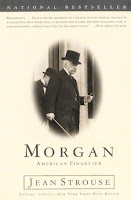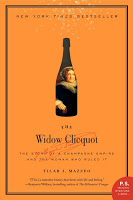 In Merchant Kings: when companies ruled the world 1600 to 1900 (M) by Stephen R. Bown describes a time a rapid industrialization when intelligent, quick-witted and ruthless entrepreneurs amassed great personal fortunes while guiding the economic destiny of their countries.
In Merchant Kings: when companies ruled the world 1600 to 1900 (M) by Stephen R. Bown describes a time a rapid industrialization when intelligent, quick-witted and ruthless entrepreneurs amassed great personal fortunes while guiding the economic destiny of their countries.
“Through the Age of Heroic Commerce, from the 17th to the 19th centuries, a rogue’s gallery of larger-than-life merchant kings ruled vast tracts of the globe and expanded their far-flung monopolies to generate revenue for their shareholders, feather their own nests and satisfy their vanity and curiosity. Their exploits changed the world during an age of unfettered globalization, mirroring a world we know today.” – Publisher Morgan: American financier (M) by Jean Strouse – This massive and detailed biography tells the story of John Pierpont Morgan, the power behind General Electric, US Steel and railroad empires. He lived during America’s Gilded Age and was a major force behind the country’s rapid industrialization. Strouse shows Morgan to have had a complex personal life in addition to possessing financial genius. Morgan’s life was plagued by frequent illnesses and he lost his beloved first wife at an early age. His second wife proved challenging and the marriage was distant. Over time Morgan developed a reputation for arrogance and bigotry. Strouse attempts to humanize this incredibly powerful man. Strouse makes the banking and financial world (almost for me) readable and there is a great deal of information about Morgan’s life as art collector.
Morgan: American financier (M) by Jean Strouse – This massive and detailed biography tells the story of John Pierpont Morgan, the power behind General Electric, US Steel and railroad empires. He lived during America’s Gilded Age and was a major force behind the country’s rapid industrialization. Strouse shows Morgan to have had a complex personal life in addition to possessing financial genius. Morgan’s life was plagued by frequent illnesses and he lost his beloved first wife at an early age. His second wife proved challenging and the marriage was distant. Over time Morgan developed a reputation for arrogance and bigotry. Strouse attempts to humanize this incredibly powerful man. Strouse makes the banking and financial world (almost for me) readable and there is a great deal of information about Morgan’s life as art collector.
Publisher’s Weekly says, “The Morgan who emerges from these pages is, for all his hard ambition and ruthlessness, not merely ruthless and greedy. By blending the different facets of this most complicated man, Strouse humanizes without shrinking or whitewashing one of America’s mythic figures.“ Mellon: an American life (M) by David Cannadine is another detailed and lengthy read. Like Morgan, Mellon flourished during the American Gilded Age, was successful in business yet less so in marriage, and left a legacy of a massive art collection. Andrew Mellon was the son of a banker and proved his aptitude for finance at an early age. By age twenty seven, he was running his own bank. He financed ventures in oil, construction, steel an shipbuilding amassing a huge personal fortune. His ventures into political life ultimately proved less successful , taking blame for the Great Depression and being prosecuted (unsuccessfully) for tax evasion. Cannadine paints a portrait of a shy and secretive man, who though brilliant in the business world, was less successful in his personal life.
Mellon: an American life (M) by David Cannadine is another detailed and lengthy read. Like Morgan, Mellon flourished during the American Gilded Age, was successful in business yet less so in marriage, and left a legacy of a massive art collection. Andrew Mellon was the son of a banker and proved his aptitude for finance at an early age. By age twenty seven, he was running his own bank. He financed ventures in oil, construction, steel an shipbuilding amassing a huge personal fortune. His ventures into political life ultimately proved less successful , taking blame for the Great Depression and being prosecuted (unsuccessfully) for tax evasion. Cannadine paints a portrait of a shy and secretive man, who though brilliant in the business world, was less successful in his personal life.
Booklist describes Mellon: an American life as “The first comprehensive biography of Andrew Mellon, the powerful American financier, secretary of the treasury, and art collector, is not only supremely informative but also eloquent and evenhanded.” There must be something about industrial financiers and art collecting that go together. American-born William C. Van Horne worked his way through the railroad business to become general manager of the Canadian Pacific Railway and the company’s president. In the course of his career he developed a telegraph service, opened hotels and launched a line of steamships. He was outgoing and gregarious and had a wide range of interests that extended beyond railroads and finance. Compared to our other captains of industry Van Horne appeared to enjoy a happy home life. He was a typical Victorian man who controlled finances and household decisions, still his family was deeply important to him and he doted on his wife and children. Van Horne was not only an art collector, but an artist in his own right. His art collection contained Dutch and Flemish masters, a large portion of which he gave to the Royal Ontario Museum. From Telegrapher to Titan: the life of William C. Van Horne (M) by Valerie Knowles was nominated for the Ottawa Book Award.
There must be something about industrial financiers and art collecting that go together. American-born William C. Van Horne worked his way through the railroad business to become general manager of the Canadian Pacific Railway and the company’s president. In the course of his career he developed a telegraph service, opened hotels and launched a line of steamships. He was outgoing and gregarious and had a wide range of interests that extended beyond railroads and finance. Compared to our other captains of industry Van Horne appeared to enjoy a happy home life. He was a typical Victorian man who controlled finances and household decisions, still his family was deeply important to him and he doted on his wife and children. Van Horne was not only an art collector, but an artist in his own right. His art collection contained Dutch and Flemish masters, a large portion of which he gave to the Royal Ontario Museum. From Telegrapher to Titan: the life of William C. Van Horne (M) by Valerie Knowles was nominated for the Ottawa Book Award. So what about a woman at the helm? Barbe-Nicole Clicquot Ponsardin, 18th century vintner, is the subject of Tilar J. Mazzeo’s The Widow Clicquot: the story of a champagne empire and the woman who ruled it (M). Madame Clicquot was known as the Grande Dame of Champagne. She was widowed at the age of 27 and took over her husband’s wine business. She developed fermentation techniques that made her product superior to that of her competitors. In her youth she lived against the backdrop of the French Revolution and as an adult entertained Napoleon and Josephine Bonaparte. She was a daring entrepreneur who grabbed hold of the freedom that widowhood provided her. Drinkers asked for her product by requesting a bottle of “The Widow”. This book is as much a history of wine as it is a biography of this remarkable woman.
So what about a woman at the helm? Barbe-Nicole Clicquot Ponsardin, 18th century vintner, is the subject of Tilar J. Mazzeo’s The Widow Clicquot: the story of a champagne empire and the woman who ruled it (M). Madame Clicquot was known as the Grande Dame of Champagne. She was widowed at the age of 27 and took over her husband’s wine business. She developed fermentation techniques that made her product superior to that of her competitors. In her youth she lived against the backdrop of the French Revolution and as an adult entertained Napoleon and Josephine Bonaparte. She was a daring entrepreneur who grabbed hold of the freedom that widowhood provided her. Drinkers asked for her product by requesting a bottle of “The Widow”. This book is as much a history of wine as it is a biography of this remarkable woman.
Source: http://www.thereader.ca/2012/02/captains-of-industry.html



